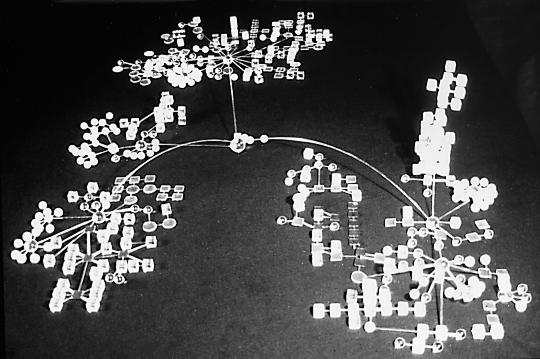Don't know whether there are still some people around using MUDs and MOO (I still do) but I am still interested in MUD/MOO (a MUD is a a multi-player computer game where everything is described with text) as a platform to investigate various concepts. Spatiality for instance is a very interesting topic to address with MUDS (see for instance in this paper some reference about it). Now that there is a map/space visualization frenziness, it's funny to find MUD maps like this one:

It's basically a model of a MOO called BayMOO. It's:
one of the most notable efforts to map the topology of MUDs was undertaken by architect, Peters Anders and his students at New Jersey Institute of Technology [3]. Anders, in an email interview, said his motivation to map MUDs was because they are designed by the players rather than professional architects, and they offered "…a source of great opportunity for architects since MUD spaces aren't subject to the consequences of material construction - and could possibly supplant built spaces in the future."
The methodology to do this quite crazy:
Mapping MUDs using field surveying and handcrafted maps obviously does not scale well to cope with many hundreds of rooms. What is needed is some means of automatically surveying the MUD as you go, recording your movement room by room and drawing the map from the results. This can be done in a simple fashion with the zMUD client from Zugg Software which includes an automapping tool
What is very smart is what they get from the analysis of this map:
Anders says his work reveals the distinct structure of a MUD from the topology of its rooms, much like a fingerprint provides unique identification of a person. The fingerprint of a particular MUD, is determined to a large degree by the political structure of the MUD, and Anders says that: "MUDs whose maps resemble an orthogonal grid of cubic rooms reflect a strong administration of wizards - a top-down control of construction in the domain. On the other hand, in democratic, bottom-up managed MUDs, users are free to build spaces without constraint. LAMs of these MUDs tend to be shaggy clusters of spheres, as the directional grid is not followed rigorously."
Why do i blog this? I like these old-school maps which I find very relevant even nowadays. Of course it's simple, but I still consider MUD/MOO and their virtual space as a good metaphor.
More about this here: "Envisioning Cyberspace: The Design of Online Communities" by Peter Anders.